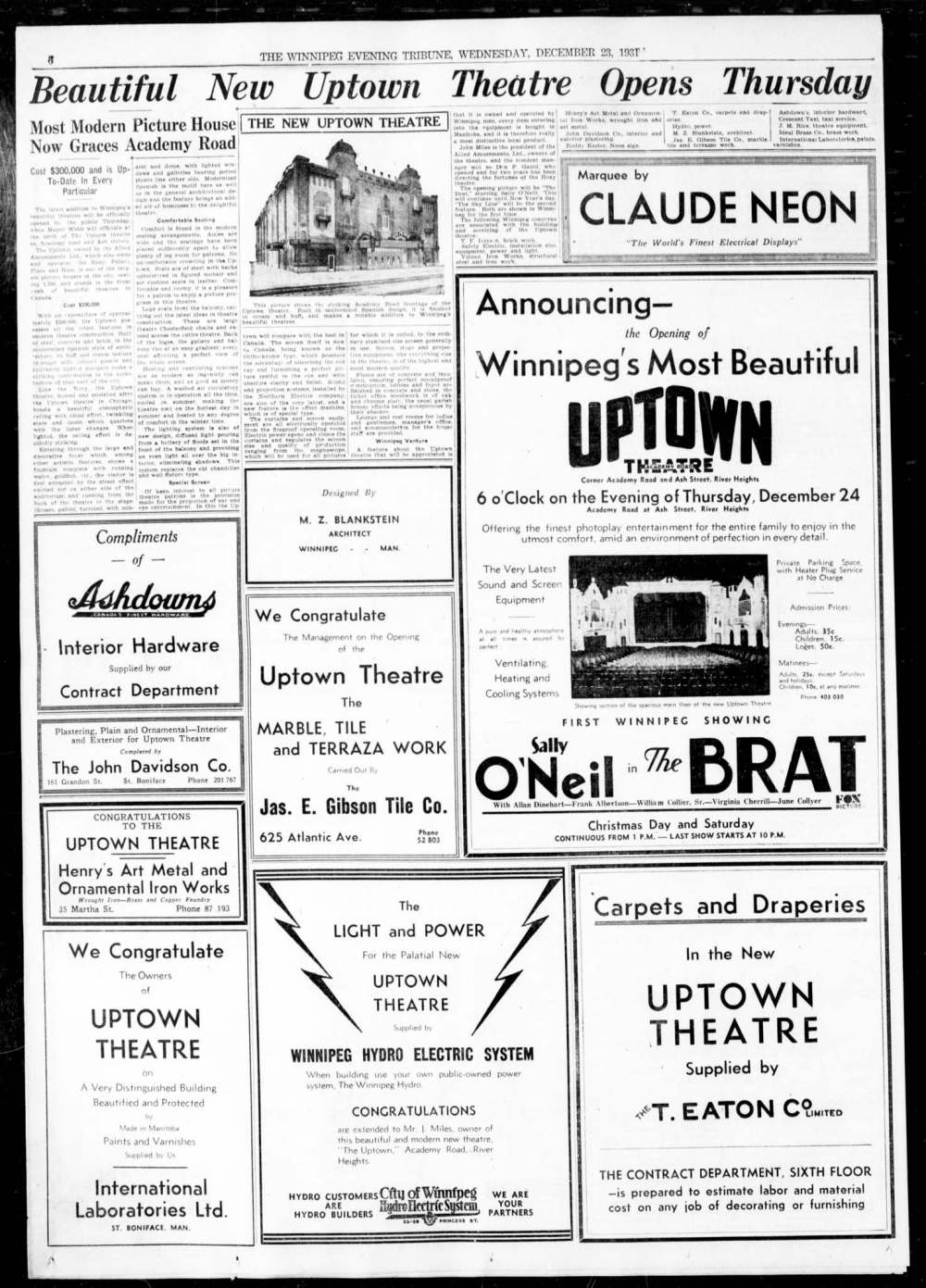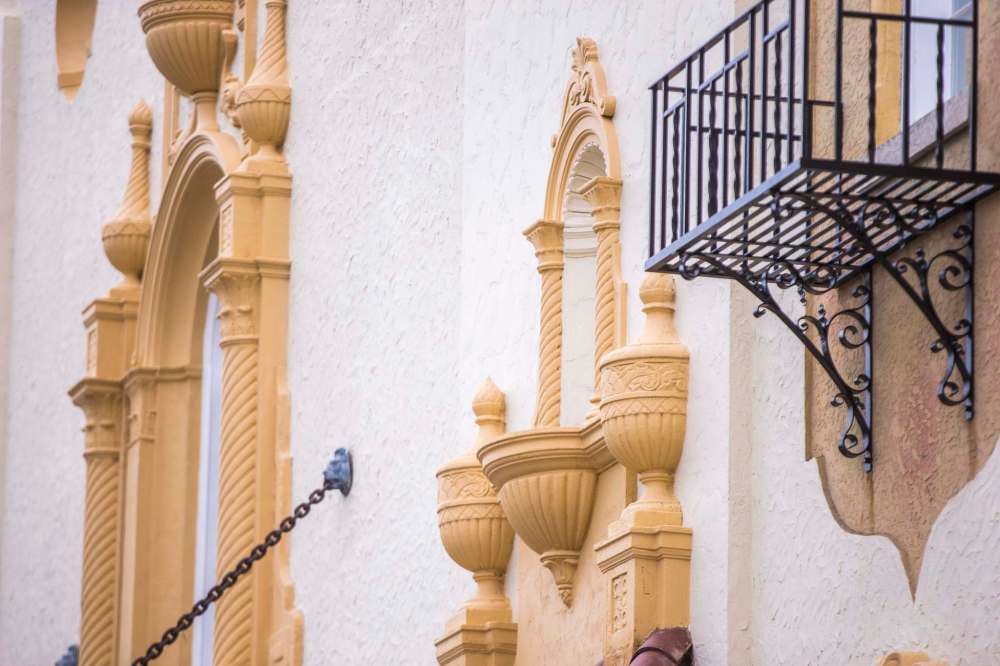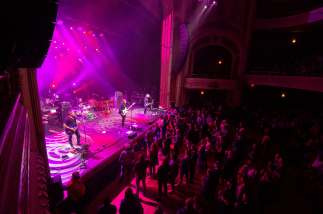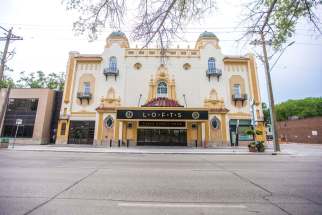Striking transformation Poetic luxuries, practical amenities put to many uses during life of Academy Road building
Read this article for free:
or
Already have an account? Log in here »
To continue reading, please subscribe:
Monthly Digital Subscription
$0 for the first 4 weeks*
- Enjoy unlimited reading on winnipegfreepress.com
- Read the E-Edition, our digital replica newspaper
- Access News Break, our award-winning app
- Play interactive puzzles
*No charge for 4 weeks then price increases to the regular rate of $19.00 plus GST every four weeks. Offer available to new and qualified returning subscribers only. Cancel any time.
Monthly Digital Subscription
$4.75/week*
- Enjoy unlimited reading on winnipegfreepress.com
- Read the E-Edition, our digital replica newspaper
- Access News Break, our award-winning app
- Play interactive puzzles
*Billed as $19 plus GST every four weeks. Cancel any time.
To continue reading, please subscribe:
Add Free Press access to your Brandon Sun subscription for only an additional
$1 for the first 4 weeks*
*Your next subscription payment will increase by $1.00 and you will be charged $16.99 plus GST for four weeks. After four weeks, your payment will increase to $23.99 plus GST every four weeks.
Read unlimited articles for free today:
or
Already have an account? Log in here »
Hey there, time traveller!
This article was published 23/08/2021 (1573 days ago), so information in it may no longer be current.
The Uptown Lofts, once the Academy Uptown Lanes and before that the Uptown Theatre, remind us that buildings can have long, varied and sometimes unexpected lives. The recent mixed-use renovation, which combines commercial spaces and residential apartments, is sleek, clean and contemporary, but it rests on layers of local memory and architectural fantasy.
The original Uptown Theatre debuted in 1931 with some Hollywood-style hoopla. The 1,600-seat theatre was designed by Winnipeg architect Max Blankstein for entertainment impresario Jacob Miles and featured an elaborate, exuberant interpretation of the Moorish style.

An account of the Academy Road structure for the city of Winnipeg’s historical building committee quotes the Winnipeg Free Press coverage of the theatre’s opening night event. The reporter in attendance praised the splendid lobby, the plush carpets and curtains, and “the dainty usherettes in choicely selected uniforms.” The mayor was there.
All this pomp was perhaps a corrective to the earliest days of movies. Local filmmaker K. George Godwin explains that fans originally watched moving pictures “in storefronts and nickelodeons, very disreputable.” By the 1920s, “when the movie business became more profitable and films were getting bigger and more respectable, they started building big theatres,” Godwin says.
And these theatres weren’t just big, according to Godwin, whose 2013 documentary Going: Remembering Winnipeg Movie Theatres offers an oral history of the theatre experience from its 1930s golden age to the ‘80s takeover of the shopping-mall multiplex. A subgenre of the movie palace was the “atmospheric theatre,” which used complex architectural schemes to call up other times and places and transport patrons to other realms. Owners of theatre chains wanted “to create these exotic places where you could experience a different kind of space,” Godwin relates.
From the mid-1920s on, these fantastical structures sprang up across North America, enticing the movie-going public with Egyptian palaces, Persian courts, Mayan temples and medieval banquet halls.
The so-called Exotic Revival styles, sometimes with a dash of contemporary Art Deco thrown in, often relied on Orientalist stereotypes to represent fantasies of exoticism and escape. Designers of architectural extravaganzas like Grauman’s Chinese Theater in Los Angeles weren’t overly concerned with accuracy, instead viewing their original sources through a lens of florid romanticism, which made for some wacky forms of cultural appropriation. Like the Hollywood dream factory that helped finance them, the atmospheric movie palaces crafted beautiful but imaginary worlds.
These fantasies would be signalled by extravagant decorative schemes on the exterior and continued through lavish lobbies. The theatre space itself was often constructed to feel like a picturesque piazza or a hidden grotto.
Blankstein’s design for the Uptown Theatre referenced the Moorish style, using architectural elements from the western Islamic world mixed with some Spanish forms.

The exterior façade, with its gridded windows and red-tiled rooflines, was anchored by two domes. Inside, the theatre space was flanked on both sides by a colonnade with arches, with plaster reliefs that suggested balconied buildings overlooking a town square. The “windows” were lit from behind, and early images of the theatre show potted plants on the balconies and even carpets hung over the wrought-iron railings.
“You’re sitting inside a theatre, but it feels as if you’re in this town square,” Godwin says. “And there was a domed ceiling, where they projected the moon going across during the movie.”
The theatre’s Brenograph projector also added moving clouds and picked up the twinkling stars inset into the dark blue plaster of the ceiling, for an atmospheric recreation of the night sky. “I wish I’d been able to see that,” says Godwin wistfully.
“You’re sitting inside a theatre, but it feels as if you’re in this town square.” – Filmmaker K. George Godwin
Alongside these poetic luxuries were some practical amenities. Movie chains helped pioneer early forms of air-conditioning, and according to a Heritage Winnipeg blog post, the Uptown proudly announced its status as Winnipeg’s only “refrigerated theatre.”
During the depths of the Depression, all this glamour was surprisingly accessible, allowing ordinary people a break from their everyday lives, not just in the films themselves but through the whole experience that surrounded them. As American motion-picture magnate Marcus Loew once claimed: “I don’t sell tickets to movies. I sell tickets to theatres.”
This maxim seemed to hold true for the Uptown. The theatre held “Sneak Peek” Thursdays, for example. “You wouldn’t even know what the movie was,” explains Godwin. “It would be a surprise.” People bought tickets for these previews knowing they’d be the first in town to see them.
But they also just wanted to dress up and make a night of it. “You were ‘going to the movies,’” Godwin suggests, and in the Uptown Theatre’s heyday, that meant something.

By the 1950s, the movie business was in decline, due to social and technological shifts, including the advent of TV. In 1960, the Uptown Theatre was converted to a 30-lane bowling alley. (Full disclosure: My father, R. Douglas Gillmor, worked on the changeover as a young architect.) Another of Blankstein’s designs, the Roxy Theatre on Henderson Highway, also became a bowling alley.
At the Uptown, “the manager of the theatre became the manager of the bowling alley, initially,” according to Godwin. The venue still offered fun, but it was nowhere near as swanky as the building’s movie days. Like many Winnipeg kids and parents, I remember birthday parties and pizza and pop, in a space that was dim and — in later years — a bit dingy.
The Uptown Lofts project, just recently completed, transforms the structure once again. It has kept the ornate building front intact, its decorative elements picked out with a fresh new paint job, and rediscovered some of the remaining historical aspects of the interior.
The Lofts’ return to partial residential use also makes an interesting callback to the building’s beginnings. When the original Uptown Theatre was proposed in 1930, “there was strong neighbourhood resistance,” Godwin relates.

“Academy was a residential street, so to put a business like that would change the tone of the neighbourhood. So, eventually, as I was told, they promised the people who didn’t want it that they’d get free admission for life, basically.”
But if the Uptown started as an unthinkable commercial intrusion, the theatre soon became familiar and, eventually, beloved. Heritage Winnipeg points out that in the mid-1980s, when rumours began to spread that the building would be torn down, River Heights homeowners Elizabeth Fleming and Patricia Gove rallied their neighbours to save it.
That successful campaign is credited with helping to develop creative solutions in adapting heritage buildings for contemporary use in Winnipeg. As a structure that has changed over many decades, from its showbiz origins to its recent facelift, the Uptown building represents that mix of old and new, residential and commercial, that makes for vibrant urban neighbourhoods.
alison.gillmor@freepress.mb.ca

Studying at the University of Winnipeg and later Toronto’s York University, Alison Gillmor planned to become an art historian. She ended up catching the journalism bug when she started as visual arts reviewer at the Winnipeg Free Press in 1992.
Our newsroom depends on a growing audience of readers to power our journalism. If you are not a paid reader, please consider becoming a subscriber.
Our newsroom depends on its audience of readers to power our journalism. Thank you for your support.





